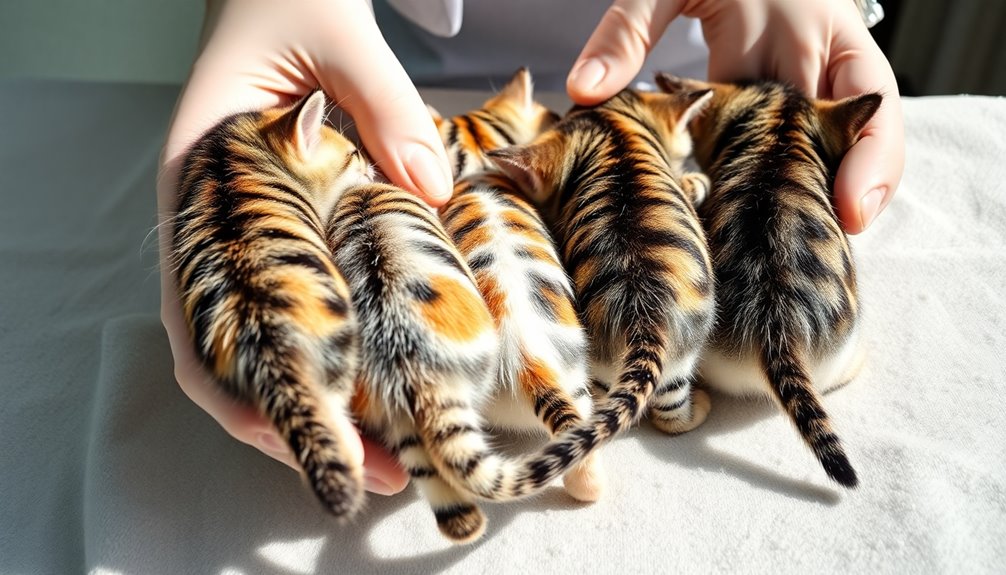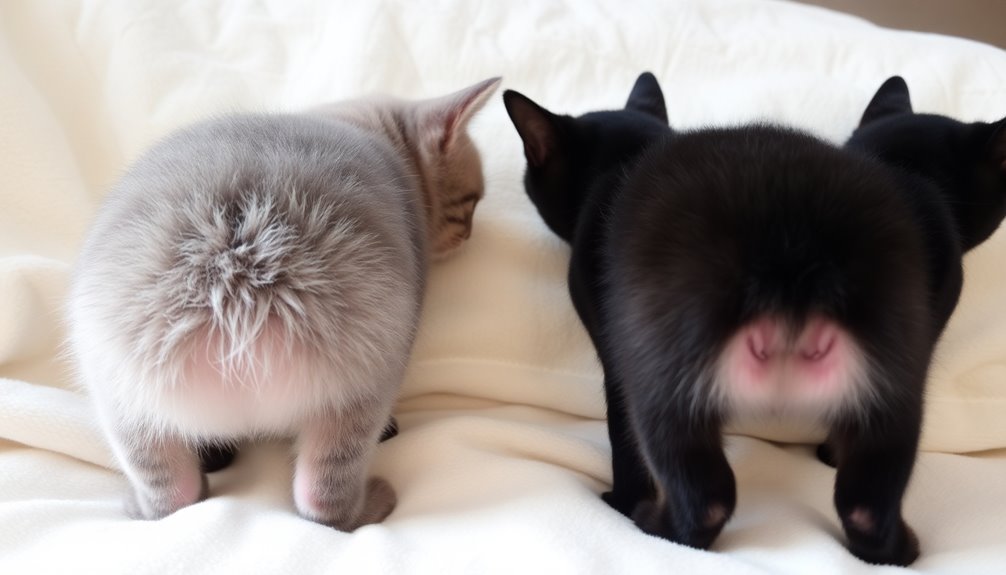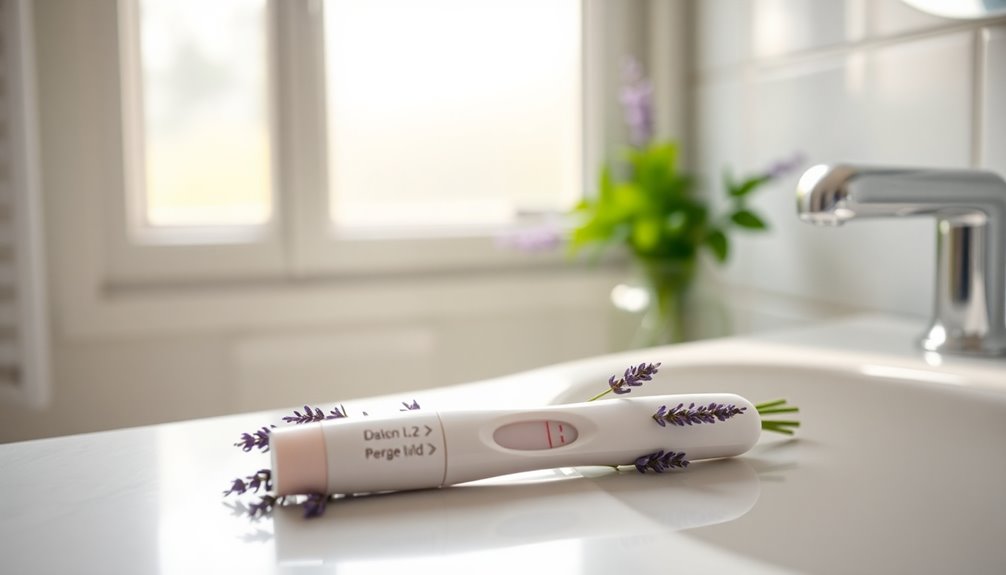To sex kittens, gently hold them and examine their genital areas. Look for the shape of their openings: males have a circular opening about half an inch from the anus, resembling a colon (:), while females have a vertical slit closer to the anus, resembling an upside-down exclamation point (¡). Males typically have more fur around their genitals. You can also observe behavior, as males may be more playful. If you're unsure, consulting a vet can help. Understanding these differences guarantees responsible ownership and care, and there's plenty more to discover about kitten anatomy and care.
Key Takeaways
- Examine the genitalia: male kittens have a circular opening, while females have a vertical slit closer to the anus.
- Look for distance: male kittens have a greater distance between the anus and genital opening compared to females.
- Observe fur density: males typically have more pronounced fur around their genitalia than females.
- Check for visible testicles: present in males between 6 to 10 weeks; palpation reveals oval shapes.
- Practice and experience enhance accuracy in identifying kitten sex; consult veterinary resources for guidance if needed.
Methods for Sexing Kittens
When you're trying to sex kittens, there are a few reliable methods you can use.
First, examine their genitalia: male kittens have a circular opening about 1/2 inch from the anus, while female kittens feature a vertical slit much closer.
For newborns, the urine flow method helps; male kittens produce a distinct stream, whereas females tend to spill.
Coat color can also provide hints—orange tabbies are often male, while calico and tortoiseshell patterns are mostly female.
By six weeks, the genitalia of male kittens will look like a colon (:) with more distance from the anus, while females appear as an upside-down exclamation point (¡).
Additionally, observe that males usually have larger body sizes and thicker tails.
Anatomy of Kittens
Understanding the anatomy of kittens is essential for anyone looking to care for or breed them. The differences between male and female kittens become apparent when you observe their genital areas. Male kittens have a round genital opening, while females display a vertical slit. The distance between the anus and genital opening varies, with males having a greater distance, and they often have more pronounced fur and tissue in that area.
| Feature | Male Kitten | Female Kitten |
|---|---|---|
| Genital Opening Shape | Round | Vertical Slit |
| Distance from Anus | Greater | Shorter |
| Fur Density | More pronounced | Less pronounced |
These anatomical details are vital for responsible breeding and care.
Identifying Male Kittens

Identifying male kittens is straightforward once you know what to look for.
Start by examining the genital opening; in male kittens, it has a circular shape and is located about 1/2 inch away from the anus. You might notice extra fur and tissue between the anus and the penis area.
Between 6 to 10 weeks of age, male kittens often show visible testicles, which can help confirm their sex. If you gently palpate the scrotum, you may feel two oval shapes that indicate a male.
Remember the mnemonic "Male = Circle" to make the process easier.
With these tips, distinguishing between male and female kittens becomes a simple task.
Identifying Female Kittens

Determining the sex of female kittens is essential for responsible pet ownership. To tell the sex accurately, gently examine the kitten's genital area. You'll notice that female kittens have their anus and vaginal opening positioned closely—typically within half an inch. The vaginal opening appears as a vertical slit or teardrop shape, making it distinguishable from male genitalia.
Here's a quick reference table to help you visualize:
| Feature | Female Kittens | Male Kittens |
|---|---|---|
| Anus & Opening | Close together | Further apart |
| Shape | Vertical slit | Round or circular |
| Fur Around Area | Less fur | More fur |
| Common Patterns | Calico/Tortoiseshell | Less common |
| Observation | Gentle and careful | Similar process |
Behavioral Differences

While you might notice some behavioral differences between male and female kittens, these traits can remarkably impact their personalities and interactions.
Male kittens often exhibit more territorial behaviors as they mature, leading to marking and aggressive play. In contrast, female kittens may show nurturing tendencies, especially if they've experienced motherhood, caring for younger animals.
When it comes to play styles, males typically engage in rough-and-tumble activities, while females lean towards gentle interactions. Also, female kittens are generally more affectionate and seek human companionship more often than males.
However, neutering male kittens can considerably alter their behaviors, making them less aggressive and more sociable, which may require veterinary care to guarantee a smooth change.
Health Considerations

Understanding the health considerations related to the sex of kittens is essential for responsible pet ownership. Early sex determination helps you make informed decisions about care and breeding. Spaying female kittens can prevent unwanted litters and reduce health risks like uterine infections and breast tumors. Additionally, spaying can help decrease the risk of health issues related to hormonal changes. Neutering male kittens lowers the risk of testicular cancer and can mitigate aggressive behaviors. Regular veterinary check-ups are crucial for early detection of any potential health issues.
| Health Aspect | Female Kittens | Male Kittens |
|---|---|---|
| Spaying Benefits | Prevents unwanted litters and reduces uterine infections | Prevents testicular cancer |
| Health Risks | Uterine infections, breast tumors | Testicular cancer, aggression |
| Veterinary Care | Tailored vaccination and health monitoring | Specific dietary needs |
Prioritizing these health considerations promotes your kitten's healthy development.
Visual Comparison Techniques

To effectively identify the sex of kittens, you can rely on visual comparison techniques that highlight the differences in their genitalia.
When examining, look for specific characteristics that can guide you:
- Male kittens have circular genital openings, about 1/2 inch from the anus.
- Female kittens feature a vertical slit or teardrop-shaped opening, closer to the anus.
- Excess fur and tissue in males can aid in confirmation.
- Observe multiple kittens in a litter to improve your identification skills.
- Always handle kittens gently to avoid causing them stress.
Additional Resources for Owners

When you're caring for kittens, online resources can be a lifesaver. They provide guides that help you understand both kitten care and sex identification, making your experience smoother.
Additionally, joining community support networks lets you connect with other owners, sharing tips and advice along the way.
Online Kitten Care Guides
While traversing the world of kitten care, you'll find a wealth of online resources designed to help you accurately sex your new furry friends.
These guides not only help you tell the difference between male and female kittens but also enhance your understanding of their fur and anatomy.
Here are some helpful online resources to explore:
- Step-by-step guides for sexing kittens
- Visual references, including images and diagrams
- Educational articles that explain anatomical differences
- Videos demonstrating proper techniques
- Community forums for shared experiences and advice
Utilizing these resources will make it easier for you to confidently identify your kitten's sex, ensuring you provide the best care possible for your adorable companions.
Community Support Networks
Connecting with community support networks can greatly enhance your experience as a kitten owner. These resources, such as local animal shelters, often host workshops on kitten care, including accurate sex identification.
Engaging in community forums and online platforms lets you share experiences and advice with other pet owners, helping you tackle common challenges. Additionally, many veterinary clinics provide pamphlets that emphasize the importance of accurate sex identification for your kitten's health and behavioral management.
Social media groups dedicated to cat care can also facilitate valuable discussions. Don't forget to explore online articles and videos from reputable animal welfare organizations to deepen your understanding of kitten behavior and responsible ownership practices.
Moreover, staying informed about personal debt forgiveness bills can help you manage the financial responsibilities that come with pet ownership.
Embrace these networks for a supportive journey!
Frequently Asked Questions
At What Age Can You Tell a Kitten's Gender?
You can typically tell a kitten's gender starting around 6 weeks of age.
By this time, their genitalia begin to show distinct differences.
By 8 weeks, you might even see visible testicles in male kittens, making it easier to identify them.
It's important to observe gently, ensuring you don't cause any distress.
As they grow, their physical traits will become more pronounced, allowing for clearer identification of their gender.
How Can You Tell Male or Female Kittens?
To tell if a kitten is male or female, you'll need to gently lift its tail and look closely.
Male kittens have a small circular opening about half an inch from the anus, while females have a vertical slit that's closer. By around 6 to 10 weeks, you might notice testicles in males.
Coat color can also help—calicos are usually female, and orange tabbies are often male.
Just be gentle during your examination!
How to Tell the Sex of Newborn Kittens?
To tell the sex of newborn kittens, you'll want to carefully examine their genitalia.
Look for the distance between the anus and genital opening; females will have them closer together, while males will be further apart.
At about six weeks, you can also identify gender visually—females resemble an upside-down exclamation point (¡) and males look like a colon (:).
How Old Do Kittens Have to Be to Sex?
When it comes to figuring things out, age often holds the key.
Kittens can be accurately sexed as early as 6 weeks old, with their genitalia becoming distinguishable. By 8 weeks, male kittens might even flaunt visible testicles, making it even easier.
Before 6 weeks, you might find it trickier, relying on less reliable signs.
Conclusion
In the world of kittens, knowing their sex can feel like deciphering a secret code. Just as you'd spot the difference between a sunny day and a cloudy one, you can learn to identify male and female kittens through their anatomy and behavior. Remember, whether you're caring for a playful boy or a curious girl, each kitten brings its own unique charm to your home. Embrace that joy, and you'll find every day is a new adventure!










